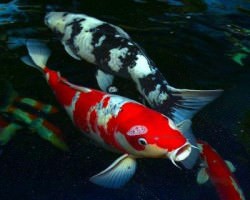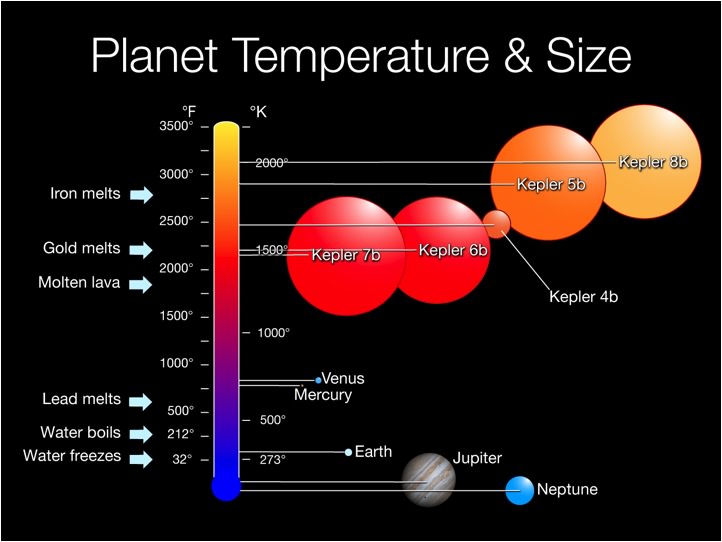By now you’ve probably heard about the first results from the Kepler mission to find extrasolar planets. Five new exoplanet discoveries were announced recently at the American Astronomical Society meeting in Washington, D.C. Four of the five new planets are larger than Jupiter, about 1.4 times its radius, and they all have orbital periods around their host stars of 3-5 days. Kepler 4b, the oddball of that bunch is about the size of Neptune.
[/caption]
All of them are close to their parent stars, so they have high surface temperatures, 1500-1800K or 2240-2780 degrees F. None of this is very surprising. We knew Kepler could detect extrasolar planet transits, and the first ones were liable to be fairly large and close in. These are the easiest to detect in the shortest amount of time.

What is even more interesting to me, is the discovery of two so-called Kepler Objects of Interest (KOI). What is so interesting about KOI?
First, they were discovered because when they disappear behind the parent star from our point of view the light from the system is dimmed dramatically. I mean a lot! Usually this phase is known as the secondary eclipse, and is much less noticeable than the primary eclipse of the star as the planet transits across the face of the star. The fact that the light was dimmed more by the disappearance of the KOI means they are blazing hot and emitting a lot of light on their own. Astronomers estimate the temperature for KOI-74b to be 12250K (21590F) and KOI-81b a blazing 13500K (23840F). The hottest known exoplanet to date is a mild 2300K (3700F) in comparison.
Both KOI are actually hotter than their host stars. KOI-74b companion star is an A1V type star with a surface temperature around 9400K. KOI-81b has a companion type B9-A0V, with a temperature of approximately 10000K.
KOI-74b and KOI-81b are not massive enough to be stars, with solar masses of 0.111 and 0.212 respectively. That’s just not massive enough to start nuclear burning in the core. Yet each object is far too hot to only be shining by heat absorbed from its companion star and then re-emitted into space. This may mean they have evolved from hot stars into their current state, and they are slowly cooling with time. The problem with that theory is, with host stars that are relatively young type A and B stars, there doesn’t appear to have been enough time for these to have evolved from massive, hot stars to the state they are in now.
 So what are they? They are the first of what will undoubtedly be a host of newly discovered objects from the Kepler mission. We live in exciting times for astronomy. We are now going fishing with new flies in the tackle box, and we have no idea what other KOI we’ll pull out of the next round of data.
So what are they? They are the first of what will undoubtedly be a host of newly discovered objects from the Kepler mission. We live in exciting times for astronomy. We are now going fishing with new flies in the tackle box, and we have no idea what other KOI we’ll pull out of the next round of data.


Obviously the answer is Koi is a StarFish
I wonder what any possible planets orbiting them would be like?
Wow – sounds like a very interesting find indeed. *Excuses himself while he takes the arvo off work to ponder said KOIs*
solar masses of 0.111 and 0.212 respectively. That’s just not massive enough to start nuclear burning in the core.
Um, I think that’s plenty massive enough for nuclear burning. Granted, they’d be red dwarfs, and they plainly ain’t, so the mystery stands, but objects of that mass can be stars – as I recall the H nuclear burning limit is 80MJ, or about .08Mo (can’t do a circle with a dot).
The difference is sustained nuclear fusions is needed for a star.
Wouldn’t it be possible for a brown dawrf to go through momentary fusion reactions if enough matter accumulates?
Also, if two Jovian planets merge/collide, would there not be nuclear results?
I have no clue how long these would last. I’m guessing no very long.
No matter the cause, I love a good space mystery! 🙂
Sorry for my spelling.
Proposed initial system:
1 Msun star and ~5Msun star in a rather tight orbit. The heavier star evolve off mainsequence and sheds over much mass to the initially lighter star, thus rejuvenating it and bulking it up. The masstransfer tightens the systems orbital parameters.
From the temperature i suspect the main star (the one initially lighter) is now somewhere 2-2.5Msun, and the ‘planet” would be the very center of the core of the initially larger star, with the atmosphere both stripmined and torched away, and cooling off slowly. 0.1-0.2 Msun stars made of mostly carbon/oxygen would be partially degenerate.
I think that would be a plausible start for investigation atleast.
This one doesn’t seem so hard. At .1 to .2 solar masses these objects can be classified as brown dwarfs. The reason they are so hot on the surface is a little harder to explain, but they are in very tight orbits around their host stars so t here are potential mechanisms to explain this. Young brown dwarfs are theorized to have be much hotter. Still a very interesting finding.